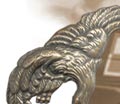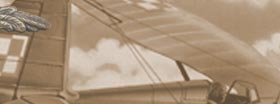Operation BLUNDERHEAD was designed to drop an agent into Estonia to sabotage the shale-oil industry and organize guerrilla bands as part of the SOE’s strategy to keep pressure and diverting military resources from the ‘front’. It was planned like many other SOE operations on the continent, but the outcome remains part history and part mystery worthy of a good spy novel.
Ronald Sidney Seth (Operation Blunderhead/ alias ‘Ronald’ or Felix Kopti) was born in Ely Cambridgeshire on 5th June 1911 and went to the prestigious Kings School. He married Josephine before the war and had two children. His past was attractive to SOE, as he had trained as a languages teacher and worked in Estonia as a professor. At 6ft 2 inches and fair haired cut a ‘dashing figure’ in his RAF uniform with the rank of Flight Lieutenant. His training taught him the skills he would need for the operation and survival in the field.
Although he was initially attached to the Polish section of SOE, he was within a smaller sub-section S (Scandinavia) He started off by collecting his battle-dress from Captain Bean at the Camberley Reception Depot, Knoll School on the Knoll Road in the leafy suburbs of Camberley Surrey before being sent to Arisaig House (S.T.S 21) on 20th January 1942, located on Arisaig under the command of Colonel Anderson. He was on special course where he would be given vigorous physical training, explosives and small arms. He also began to develop his ‘persona’ and infiltration techniques as a deck hand on a coastal steamer into Estonia. He adapted well to the training programme and was described as ‘enterprising’ and ‘highly strung’ (PRO/HS4240/112089) and by February 1942 was being marked down for a parachuting course at Manchester Ringway. Initially the coaster ‘Daxhound’ had been earmarked for infiltration by the Ministry of war Transport. However, the Baltic was icebound for longer that winter, plus Ron injured his knee during a night exercise and was hospitalized in the military hospital at Onich caused the plans to be delayed. While recovering SOE were developing his ‘cover’ of a seaman who had worked extensively in South America where details of ships in Rio and Buenos Aires, port facilities and even the local brothels were collated. Royal Mail Lines Ltd confirmed ship movements on 2nd March 1942 in a letter to Major Hazell and Ron had been on the M.V Stegeholm, which docked in Gottenburg on 18th September 1942 from Buenos Aires.
On 5th March 1942 Ron was posted to Beaulieu (S.T.S 36) for his Finishing Course with W/T training at S.T.S 31. His ‘story’ was now complete and would be Felix Kopti (married to an American) an Estonian fed up with South America and had stowed away on a Swedish ship. Felix Kopti had a girlfriend named Hilda Palmer who had lived in Croxted Road, Southwark in London where copies of letters were used to practice the forging the handwriting. Ron also had connections with Sweden through the Munck family in Rosenchild who had a daughter working in a music shop in Stockholm.
By October 1942 the training and cover story were in place with specialized equipment and fake Estonian passport being made plus Ron was promoted to Captain. In a report from Captain H. Watts from S.T.S 17 Ron was briefed on how to sabotage the rotary retorts used to process shale oil. In 1939 to 1940 new Davidson rotary retorts had been installed in Estonia and plans were still available to assist in the planning of their destruction.
Ronald Seth was parachuted into Estonia on 24th October 1942 leaving behind an anxious wife and debts. Josephine became more settled when being commissioned as an officer in the WAAF and posted to RAF Compton Bassett near Calne in Wiltshire where she met some old friends.
The Mission
Ronald Seth’s mission was to: -
- Ascertain the quantity of oil being sent from Estonian wells to the Leningrad front
- Ascertain the quantities of oils being sent to Finland, Sweden, Latvia and any other countries
- Carry out acts of sabotage to railways in the oil fields and the main line between Tallinn and Leningrad
From the PRO archives the mission went wrong and there are several accounts as to what happened. In intelligence report from S.I.S (CX/22640/21/2961) dated 17th September 1943 an Estonian coastguard reported a parachute had been seen by the Germans in the Hara area and had ‘swept’ the area with little success, but reports were made the parachutist had been seen near a farm near Loska. It appears the farmer and local people knew the ‘visitor’ as the person visited the area for summer holidays and was known to have taught English in Tallinn before the war. The report indicated the agent was arrested and taken to Tallinn for interrogation.
On 21st June 1943 Ron was officially posted as ‘missing’ and also recorded as a security risk due to a captured document transmitted to S.I.S in Switzerland (see notes below).
Ronald Sidney Seth was reported to be in good health in Paris in August 1944 and became the centre of a high-level security operation. Captured documents and subsequent interrogation by various British ‘agencies’ (S.I.S, M.I.3, M.I.9) tried to establish the true story. The following notes are made from the files under PRO/HS4/240/112089.
- It is known the pilot of the Halifax parachuted Ronald Seth at 23.30 hours onto the Leesi promontory and a little short due to the time and residual fuel for the return flight. He should have been dropped at Kunda Bay another 50km away.
- 3 containers disguised as lumps of wood containing the W/T set with batteries and generator, explosives, tent and other field equipment.
- Ronald Seth was carrying 7,400 Swedish Kroner, $1,400 US, 100 Reichmarks in coins, 100 Soviet Roubles, compass, pistol and a poison tablet.
- His interrogation by the Luftwaffenfenlshaber indicated he had no intention to complete the mission and abandoned the equipment in a wood close to the farm at Loska.
- He was arrested by the Estonian ‘Home Guard’ and handed over to the German authorities when the purchase of a boat and escape to Sweden appeared fruitless
- Interrogated in Tallinn and while incarcerated met Soviet agent Anton Prohkorov who indicated agents were being smuggled into Norway on subversive missions to create trouble after liberation.
- Interrogated on 26th February 1943 in Berlin, tortured and threatened with being shot. Agreed to work for the Nazis.
- In April 1943 two German aircraft force landed in Switzerland. A copy of a report of an interrogation at Dulag Luft at Oberursel naming Seth. Since nothing had been heard from him or the IRC it was assumed he had perished. His wife was given additional financial support while listed as missing.
- Agreed to work for the German Air Ministry and brought to Paris in May 1944 to train as a double agent and the training programme was completed by August 1944.
- Sent to Offlag 79 in August 1944 on the orders of Count Donhoff (believed to have escaped to Switzerland before the collapse of Germany) who suggested Seth should become an informer working for the German Foreign Office under the disguise of Captain John de Witt (classified as agent 22D) to distribute Nazi propoganda amongst POW’s. Colonel Brown RA acting as Senior British Officer (S.B.O) was suspicious.
- During interrogation by SIS in 1945 gave inaccurate details of S.O.E training and claimed the Soviet Union was going to communise Europe and that Germany could never be truly democratic and Stalin would communise Germany through the Seidlitz Committee. He also claimed a moderate Nazis under Himmler would settle with Britain and the Allies in return to fight the Soviets.
- M.I.5 interrogation report on agent Pawel Rybicki gave information about the suicide of a British Agent in Gydnia who matched Seth’s description.
- On 11th March 1944 he met leading Nazis and was given special political mission. He was sent over the Swiss border to meet German agents and carried invisible ink and codes.
- Josephine Seth was informed in July 1944 Ronnie was officially listed as missing. Correspondence from his wife dated 21st July 1944 indicated she was convinced he was still alive.
- On 13th April 1945 Seth reports to the military attaché in Berne. (Initial interrogation makes up part of this chronological report of events). He claimed he agreed to be a double agent to avoid execution and was prepared to re-enter the field to double cross the Germans.
- Handwriting samples of Captain John de Witt matched file copies held in S.O.E’s personnel files of Ronald Seth.
- Letters to and from his wife were censored and screened to make sure there was no coded text.
- Ronald Seth left Switzerland under the name of John de Witt on 18th April via Geneva, Lyon and was interred in No.90 Reception Camp, Vache, Chalfont St. Giles Buckinghamshire for interrogation which took place for several months.
- With increasing pressure from various agencies and lack of proof Seth was moved to RAF administration duties and recalled periodically to clarify information as M.I.5 could not substantiate some aspects of his case.
- He claimed to have joined RAF bomber squadron, promoted to Group Captain and made K.C.B. Seconded to S.O.E for operations in Estonia. (Here Seth forgot to divulge that he was nearly court-martialled and demoted for refusing to obey orders).
Traitor or clever at having ‘conned’ the Germans into letting him live – who knows, but after the war Ronald Seth was successfully writing books on espionage.





